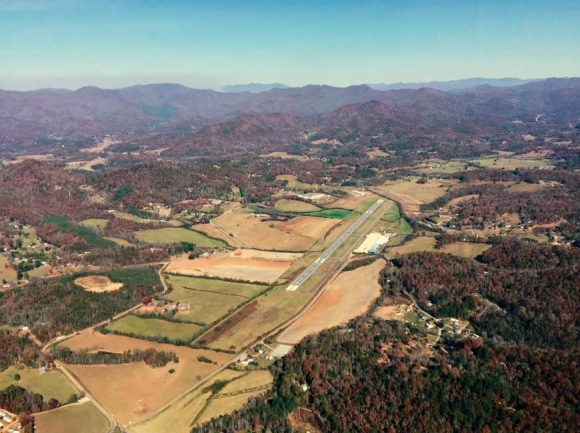Macon Airport Authority still eyeing expansion project
 Macon County Airport.
Macon County Airport.
The Macon County Airport Authority may have hit a roadblock in the planning process for a project that will add another 1,000 feet to the runway.
The North Carolina Department of Transportation approved $4.5 million for an expansion project that will provide safety upgrades at the small private airport, but unfinished work from the last runway expansion project in 2011 could hold up progress.
Airport authority members were surprised to learn several months ago that the archeological piece of the project started in 2009 — meant to document and catalogue any Cherokee artifacts found on the land being disturbed — was never completed.
Airport authority chairman Miles Gregory said he was worried the uncompleted work will mean delays for the next project.
Back in February, Paul Webb with TRC Environmental in Chapel Hill — the firm contracted to complete the archeological work during the last extension project — presented the authority board with an update on the project and asked for an additional $193,000 to complete the last phase within the next 18 months. That includes cataloging the items discovered, completing a final report and displaying the artifacts.
The airport authority will have to use NPE (Non-Primary Entitlement) funding from the Federal Aviation Administration to pay for the additional work needed. General aviation airports receive $150,000 a year from the FAA in NPE funds to put toward safety and building improvements, but it requires a 10-percent match from the county government. The Macon Airport Authority has two years’ worth of NPE grants available to put toward the project as long as the commissioners approve the match.
Related Items
Authority members said they had no idea that portion of the project wasn’t completed back in 2011. Webb was invited back to the authority’s June meeting to answer more questions about the work still needed.
“The board is trying to be patient with the process but the concern we have is it’s taken so long — going on nine years now — and we don’t understand the mechanics of the EPA and the other environmental people, but we’re in the process of adding another 1,000 feet hopefully… why does it take so long?” Gregory asked.
Webb said there hadn’t been any more work completed on the project since 2014, but now the Department of Aviation has made it a priority again.
“The hold up is we haven’t had the funds,” he said.
He said these types of delicate archeological and environmental projects took a long time because a certain “sequence of operations” has to be followed when collecting these materials.
“Certain analysis has to be done first before we can move on to the next step,” Webb continued. “Did it stretch out longer than it needed to? Yeah, but not a lot considering the scope of this project — it takes a while to deal with those materials.”
Knowing another environmental and archeological study will have to be done for the next runway extension, Gregory asked how long it would take to complete the next project.
Webb said it was hard to say — it’s really depends on what the North Carolina State Historic Preservation Office, the Eastern Band of Cherokee Indians and the Federal Aviation Administration decide is required.
“That property out there has been farmed and disturbed for over 150 years, so I don’t think it will require as much,” Gregory said.
Webb said $193,000 would definitely be enough to complete the outstanding work so the airport authority can proceed with the next project, which could still be several years out. He added that while the recording and displaying of the work was included in the original scope of work, it was never funded in the final request for proposals because of budgeting concerns.
Even if the entire scope of work wasn’t included in the final contract, authority member Richard Rhodes said he still couldn’t understand why a change order wasn’t done to finish the work when the project was still in progress.
“That should have taken care of everything — to me it’s nine years later and you’re coming back saying you need more money,” he said.
Airport Authority Clerk Teresa McDowell said the issue was brought up during the project but that the Division of Aviation didn’t make it a priority until now.
“This shouldn’t hold up other grant funding. It wasn’t our fault and should have been done as the grant was closed out,” Rhodes said. “It looks to me like it shouldn’t hold the project up now.”
Airport authority attorney Joe Collins asked Lori Hall, the county’s finance officer, about the steps needed to get the financing for the project.
Hall said a representative from the airport authority would need to get on the agenda for the July 10 board of commissioners’ meeting to request the NPE matching funds, which would be a request for $33,334. The commissioners have already approved $450,000 in matching funds for the next runway expansion project.
Authority member Tommy Jenkins made the motion to authorize someone to request the funds from the county and it passed unanimously.
County Commissioner Karl Gillespie, liaison to the airport authority board, said the authority representative should be prepared to answer some questions before the commissioners regarding the past and future expansion projects.
“I think knowing my fellow board members, I think there’s questions I don’t have the answers to that would be helpful to have ahead of time,” he said. “The obvious question that will be asked is what was the original scope of work and was it not included in the original scope?”
Authority members said they would put together a brief history of the project and an update on what’s going on to present to commissioners.
Last expansion
The 2009 expansion project, which expanded the runway over Cherokee burial grounds, was met with a good deal of opposition from the community. Even today the debate continues over whether the airport is a never-ending sap on taxpayer dollars to accommodate a few wealthy people that use it or a major economic development benefit.
Macon County based companies and large employers like Drake Enterprises and Duotech Services have said the airport is extremely beneficial to their businesses. It helps them operate out of rural Western North Carolina and still be able to fly employees all over the country to meet with customers.
When the last expansion was proposed, some residents said disturbing Cherokee burial ground was disrespectful and others felt the need for an expansion didn’t outweigh the environmental impact it would have on the area.
While Cherokee artifacts can be found in many places throughout Macon County, an archeological assessment at the time said the airport property was one of the more significant areas in the state.
At the request of the Eastern Band of Cherokee Indians, none of the estimated 400 burials were to be removed from the area. The airport authority only wanted to excavate 25 percent of the artifacts from the 5-acre project site, but EBCI wanted 100 percent of the artifacts removed and preserved.
The entire project cost, including $535,000 for archaeological work, ended up costing about $4.5 million. Ninety percent of the funding came from the N.C. DOT Division of Aviation and 10 percent from a county match. At the time, the authority said it would cost $2 million to excavate 100 percent of the materials.
When the authority submitted its permit application to the U.S. Army Corps of Engineers, which would allow a creek within the project site to be rerouted, it was denied until the authority addressed the concerns from EBCI as well as the U.S. Fish and Wildlife Service and the North Carolina Wildlife Resources Commission.
By 2011, the expansion project was completed and the artifacts removed, but apparently the recording and displaying process for the material was never finished.
Future expansion
The authority also discussed the future expansion project to extend the runway from 5,000 to 6,000 feet, which will better accommodate larger private jets.
Jimmy Luther, engineer for the authority, said he has developed four different plans for the expansion work, which will be submitted to the DOA and FAA to evaluate and decide the best option.
Ideally, Gregory said he’d like to see the entire expansion happen on the west end of the runway since there is a creek on the east end that would make the project more time consuming and costly. He added that the neighboring residents on the east end had already made it clear they didn’t want the runway any closer to their property as the larger jets fly right over their home.
On the other hand, jet pilots complain about having to hit the short runway at 160 miles an hour and wearing out their brakes — which can run $30,000 to replace — to be able to stop in time.
“The neighbors are upset — a big plane came in and shook their house. The plane (pilot) couldn’t make the turn quick enough to stay off above her house,” Gregory said. “I’m concerned about that. We may not be able to but I want us to do everything we can do to put everything out on the west end.”
While there is about 1,200 feet of property on the west end to work with, Luther said it would cover the 1,000-foot runway extension but wouldn’t be enough to cover the additional land required for a displacement threshold.
“Whatever we do isn’t going to be the best solution, but it will be the best we can do with what we have,” Luther said.
“Can’t we just let them take off from that end?” Richard asked.
“Yes we can, but they may not let us do it — they may say it’s not worth millions to not benefit the pilot up in the air trying to land,” Luther said.
In order to do the entire expansion on the west end, the authority would have to purchase another 500 feet of land. Building it on the east end would mean involving the U.S. Army Corps of Engineers for further environmental impact studies and mitigation efforts.
The airport authority will continue to move forward with the preliminary work for the next expansion project and hope the remaining work can be completed in the next year as not to hold up construction plans for the next expansion.
Macon County Airport history timeline
• 1969 — Macon County Airport was opened under county ownership.
• 1995 — A husband a wife died in a plane crash trying to land at Macon County Airport.
• 1998 — The North Carolina General Assembly established the Macon County Airport Authority and the county deeded the land and facilities over to the authority. Peggy Milton and Neil Hoppe, owners of Franklin Aviation, received a 20-year contract from the county to manage Macon County Airport. That contract expires this year
• 2009 — Macon Airport Authority receives criticism over a proposed runway extension from 4,400 feet to 5,000 feet after an archaeological assessment called the site one of the more significant areas in the state because of some 400 Cherokee burials and artifacts.
• 2011 — The 600-foot extension to the runway at Macon County Airport is completed to the tune of $4.5 million. The project was paid for with a combination of federal, state and local dollars.
• 2012 — A plane crash at the Macon County Airport kills five people.
• 2013 — Macon County commissioners narrowly approve providing a $290,000 local match in order to get a $2.5 million grant from the FAA and DOT to repave and widen runway from 75 feet to 100 feet.
• 2016 — DOT wants to complete another $4.5 million expansion project to lengthen the runway from 5,000 feet to 6,000 feet. Commissioners voted unanimously to support the project, which will require another 10 percent match — $450,000 — from local coffers.









